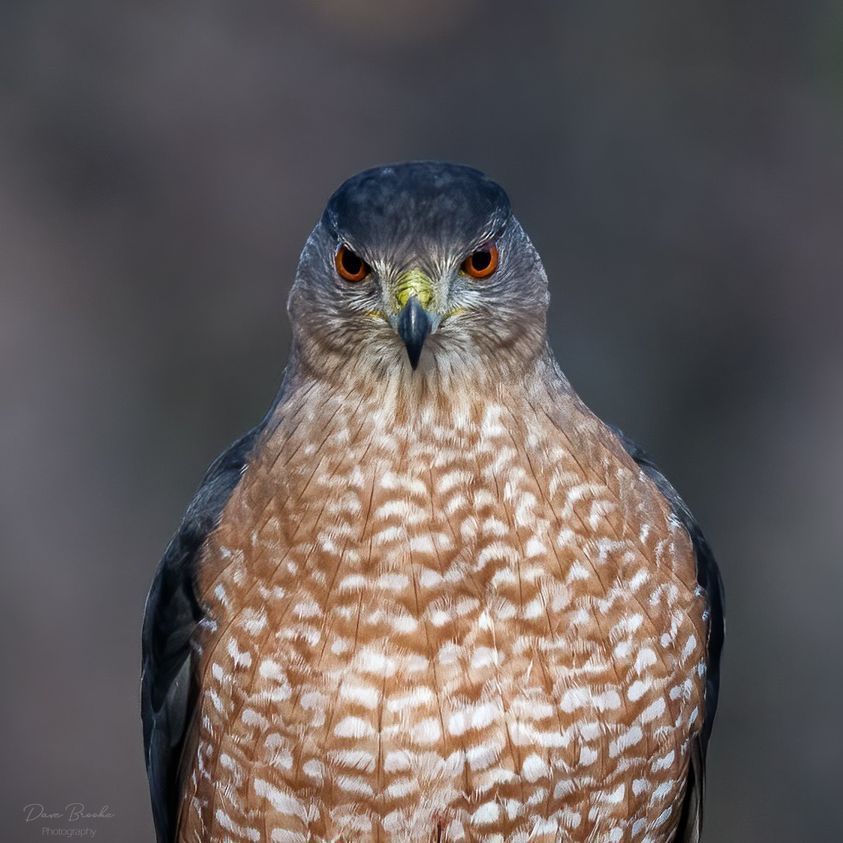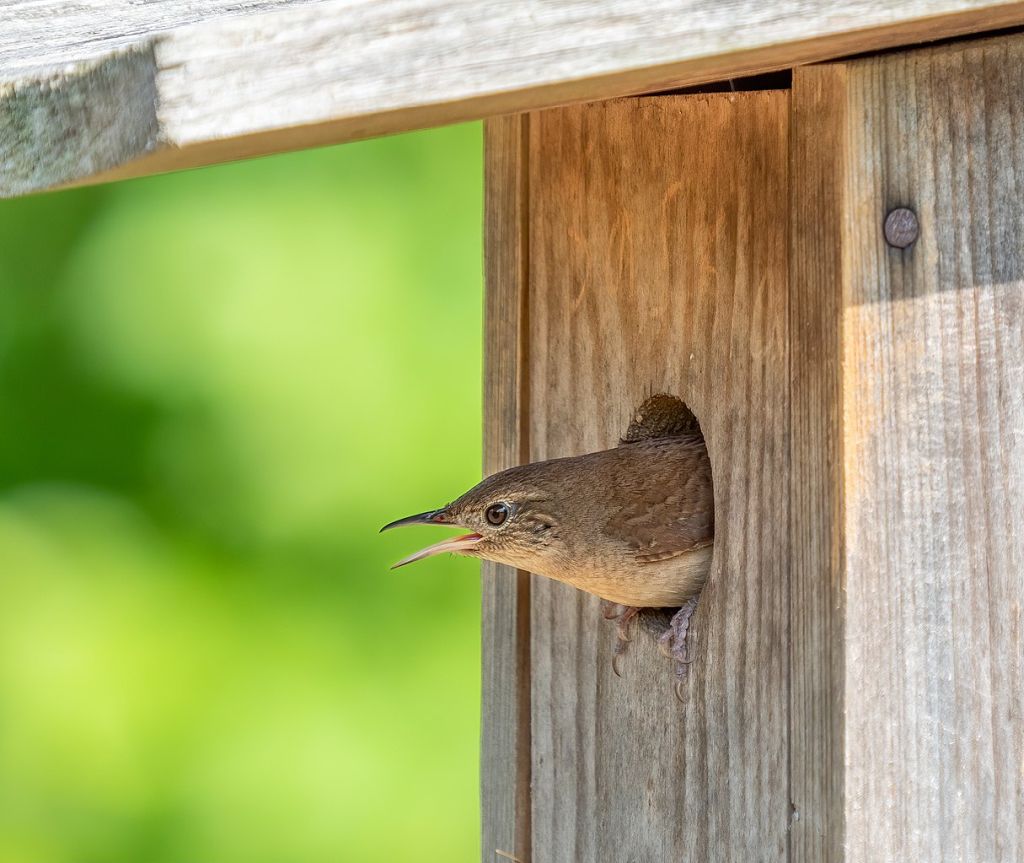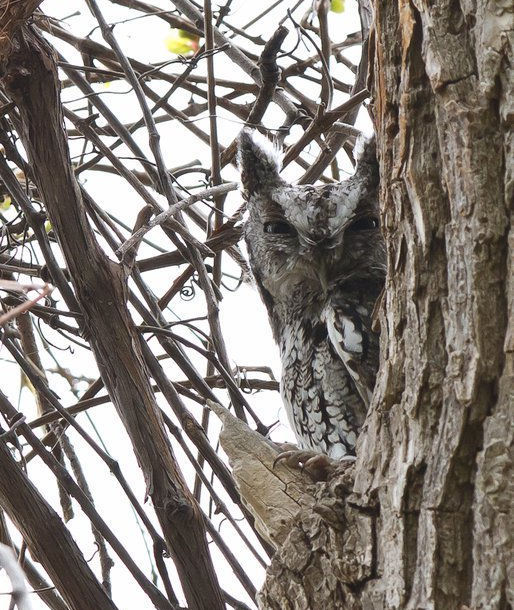
8 September 2021
Fear causes an inability to thrive in humans. Now a new study shows this is true of birds as well.
As a grad student at University of Massachusetts in Amherst, Aaron Grade decided to parse out why urban nestlings are lower weight than their rural cousins. It’s well known that urban settings have poor habitat, altered food sources and more predators but the likelihood of predation is lower there because urban predators have so many other food choices.

Grade wondered if fear play a role so he set out 38 house wren nest boxes and loudspeakers in participants’ backyards in urban, suburban and rural western Massachusetts. During the nesting season participants played back the sounds of two predators of house wrens: Cooper’s hawks (pictured at top) and eastern screech-owls (below).

Though there was no actual danger, parent house wrens responded to the sounds by guarding their young and perhaps feeding them less. In the end nestlings in these playback settings were 10% underweight no matter what habitat they grew up in.
The study found that whether the birds are hurt or not, their nestlings are underweight and less likely to survive if the family lives in fear.
“These landscapes of fear,” says Grade, “can have a greater effect on behavior and survival than the actual predator itself.”
— Science Daily: How landscapes of fear affect the songbirds in our backyards
Birds and humans cannot thrive in constant fear.
Read more about the birds at Science Daily.
Read about humans at Low Birth Weight Babies and Black Women: What’s the Connection?
(photos by Dave Brooke, Wikimedia Commons and Bobby Greene)
p.s. This is also a lesson for birders: Avoid using playback of predator sounds, especially during the spring and summer nesting season!
Wow, fascinating Kate!! Thanks – hope you guys are well. Anytime you wanna get a cup of coffee or lunch or something give me a call!! Miss you!!
Fascinating, thanks for posting Kate.
On another note, I noticed the Cooper’s Hawk you have pictured has red eyes. I recently had a Cooper’s Hawk in my back yard thus I was able to get a good long close look at him and noticed his eyes were green like mine. After seeing the picture you placed I had to look on line and see other images to see what color eyes those had and amazingly I saw quite a range of eye colors from yellow to red and green to light brown. Who knew? Again fascinating bird stuff.
Gene, I know the immatures have yellow eyes but didn’t realize there were other eye colors as you found so I looked it up in Birds of the World where it says:
Iris is bluish-gray in fledglings, increasingly replaced by yellow in first year. In brief, yellow or light orange in yearlings, shifting progressively to darker shades of orange and red with age, males averaging darker than females of same age, and detectable change ceasing at about 5 years of age, although eye color is generally an insufficient means of aging an individual, owing to variability of eye color within an age group.
(i.e. Adults have red eyes.)
I’ve never seen one with green eyes.
Kate – Have you seen any of the documentaries about how the reintroduction of top predators in habitats from which they have been missing benefits the ecosystem? NOVA has the show, Nature’s Fear Factor, about returning wild dogs to Gorongosa National Park in Mozambique. There’s another show about the effect of wolves being returned to Yellowstone, but I can’t remember the name. Having the predators present has a pretty dramatic effect on the system, preventing overgrazing and other problems. When I watched both of those shows, though, I kept thinking about the fact that the prey animals were losing their slice of Eden, where they could live without the fear and stress of having predators nearby. Of course, here in Pennsylvania we have the rather out-of-control deer population with the loss of most predators. The irony, IMO, is that loss of habitat to humans is leading to extinctions while natural predators served to keep nature in balance and more healthy for the animal populations.
Mary Anne, yes I’ve read about the benefits of having top predators in a habitat. (Can’t remember where I learned about wolves in Yellowstone but it was fascinating.) I have also seen it for myself. Before the peregrines arrived at Pitt the pigeon population was huge, lazy, and some were sickly. The weak pigeons lived because there was no one to hunt them. Within a couple of years of Dorothy & Erie’s residence at the Cathedral of Learning the pigeon population was lower and definitely more nimble! Any pigeon that didn’t fly fast and pay attention was gone. … You’re right about the irony of humans’ effect on the world. If we didn’t grow our own food humans would be the top predator in the wild. There is still one wild animal we still hunt extensively — fish — and we are placing a lot of pressure on them because the human population is so huge. Humans’ top predators are viruses/bacteria/parasites and ourselves.